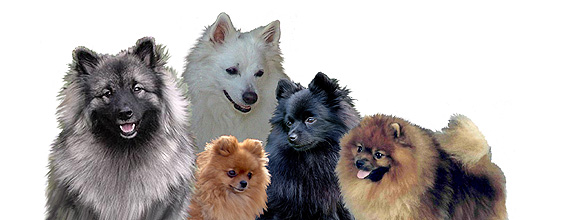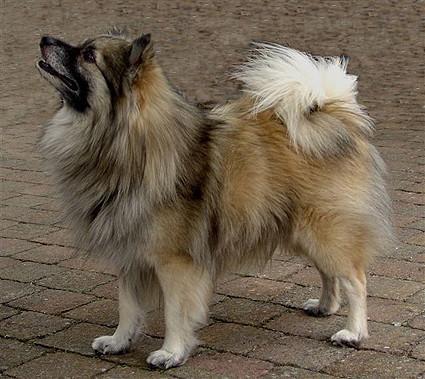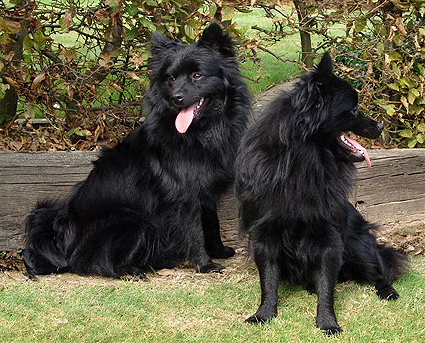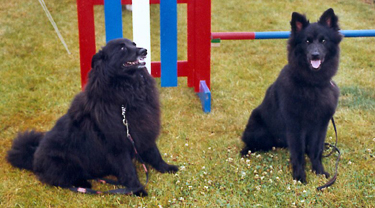van't Kezenhoeveke
The German Spitz
By : Erna Van Bavel & Marie-Josée Vanhaelen Copyright Deutscher Spitz Club of Belgium (DSCB)
|
What kind of breed is this...?
... may you be wondering. In Belgium, but particularly in the Netherlands, these dogs are well known as ‘keeshond' or ‘loulou'. |
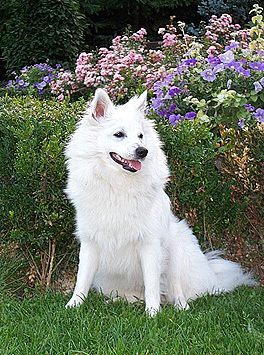 |
 |
A special appearance
The Spitz is a happy, outgoing, temperamental and very affectionate dog. They belong to breed group 5: “the Spitz and primitive types”. This means that they have the looks of this breed group: compact triangular ears close together and high set, a pointed nose and a very bushy tail rolled on his back. The Spitz is still a very ‘true-to-nature' dog. His appearance has not changed a lot throughout the centuries. But a Spitz is more than that: with his gorgeous, stand off coat; his compact square appearance; his lion like manes around the neck, shoulders and chest; his richly plumed tail; the dark, bold look in his eyes and his flowing, springy drive, he is the pride and joy of every owner. So a Spitz has a very striking appearance with a lot of charisma. |
Five varieties and a whole range of colours
Everyone can find a German Spitz he fancies. Almost any size or colour is available. Next we will list the five sizes and the occurring colours. |
1) The Keeshond or Wolfspitz (43-55 cm)
The Keeshond (in Belgium also called the ‘Wolfspitz') is the biggest variety of all the German Spitz. He gives a quite impressive impression with his gorgeous wolf-like coat, silver grey with black hair-tips, and his distinctive markings of ‘spectacles' around his eyes. |
 |
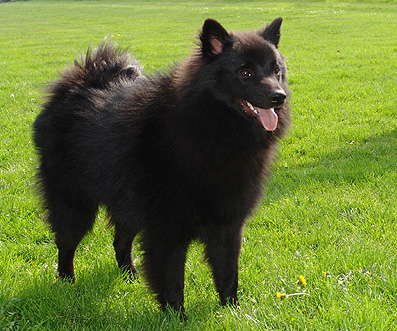 |
2) The Giant Spitz (42-50 cm)
The Giant Spitz coat colours are white, black or brown, although most Spitz-lovers won't even remember the days the Giant brown Spitz existed. But also for the Giant white Spitz and especially for the Giant black Spitz it is high time. A handful of Giant Spitz lovers from Germany, the Netherlands and Belgium, in association with the breed club, put their shoulder to the wheel and are trying to preserve this beautiful variety. |
3) The German Spitz Mittel (30-38 cm)
The Medium Size Spitz comes in a wider variety of coat colours: white, black, brown, orange, grey-shaded, other colours. The term “other colours” covers all shades of colour, such as: cream, cream-sable, orange-sable, black and tan and particolour. The white variety, the loulou, is the most known, while the other colour coats, especially the black and orange dogs, are becoming rare. |
 |
 |
4) The German Spitz Klein (23-29 cm)
The coat colours of the Miniature Spitz are identical to those of the Medium Size Spitz: white, black, brown, orange, grey-shaded and other colours. The Miniature Spitz is better known and is more frequent, mainly in the colours orange and white. In both the Medium Size and the Miniature Spitz, we try to maintain the pure colours (orange, white and black). |
5) The Pomeranian or Toy Spitz (18-22 cm)
In the Pomeranian every coat colour may be mixed, because there is only one champion's title (CAC) for the best male and one title for the best bitch. Some breeders also try to maintain the pure colours, and this is good thing because otherwise these colours might disappear within the Pomeranian. |
 |
A bit of attention for the less known varieties of the German Spitz
While the biggest variety, the Keeshond, and the smallest of them all, the Pomeranian, are without a doubt the most popular, there are three other varieties of the German Spitz far less known. One of them is the German Spitz Klein. They are quite frequent but a lot of the owners do not know this Spitz very well and they think they have a Pomeranian. This confusion comes from the small differences in size: the biggest Pomeranian may measure 22 cm, while the smallest German Spitz Klein measures 23 cm. Because of their abondant coat this tiny difference is very difficult to observe, and even Judges have to take their measuring rod.
The other two varieties, the German Spitz Mittel and the Giant Spitz are less known because they become hard to find.
One exception is the German Spitz Mittel in the color white. In general these are dogs without a pedigree, here in Belgium. Therefore it is impossible to prove that they are of pure race. This is the reason why they are never or very rarely used as enlargers of the breeding-base of the medium sized white Spitz with pedigree. So next to a small number of these dogs with pedigree, there exists a much larger number of dogs without a pedigree.
Unfortunately the situation is more dramatic for the other colours of the Mittel Spitz. They are even more seldom seen. The orange, brown, black and grey Mittel Spitz are even so rare that they are becoming scarce. With a bit of luck you can find one on an important dog show.
The situation is the same for the Giant Spitz. When we consider the Giant white Spitz as a rarity, the giant black spitz practically does not even exist anymore. You can still find a small number of the Giant white Spitz in the Netherlands and Germany, and a few specimen in Switzerland, Austria, Czechia and... in Belgium. The Giant black Spitz is the real ‘underdog' of the breed. There is a very limited number of specimens in Germany and Czechia, but in the other countries this variety does not occur anymore. And although the Giant brown Spitz is still mentioned as a variety amongst the Giant Spitz, it is not even clear whether they still exist...
This year, in Germany, the German Spitz Mittel and the Giant Spitz have both been declared a “threatened breed of dogs”. The reputable magazine about dogs “Woef” has dedicated an article in their April-edition of 2003 to the Giant Spitz and the critical situation for this variety. In Germany, the Netherlands and Belgium different newspapers and magazines regularly publish articles to broach the problem. All of this is all the hard work of concerned owners, breed clubs and breeders which all want the problem to be known. They also try to stimulate people who want to buy a dog, to consider purchasing of a Mittel Spitz or a Giant Spitz... Only they know best how much it is worth the effort to give these beautiful, sweet and affectionate dogs a chance of survival...
Do you want more information? The breed club of Belgium, the “Deutscher Spitz Club of Belgium”, briefly DSCB, will gladly help you. Please contact the president Mrs. Marie-Josée Vanhaelen Tel 0032 15 62 38 19
|
All pictures & texts © van 't Kezenhoeveke
!!! Put the arrow on the pictures to see a short comment !!!

